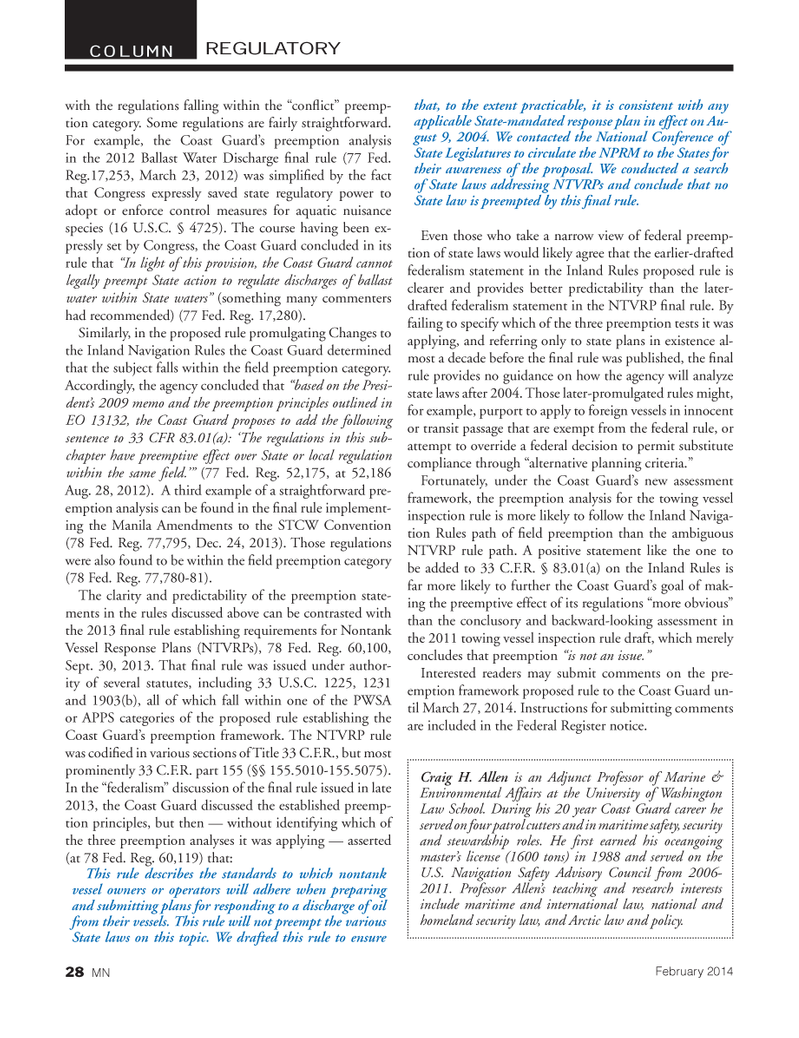
Page 28: of Marine News Magazine (February 2014)
Combat & Patrol Craft Annual
Read this page in Pdf, Flash or Html5 edition of February 2014 Marine News Magazine
with the regulations falling within the ?con ict? preemp- tion category. Some regulations are fairly straightforward. For example, the Coast Guard?s preemption analysis in the 2012 Ballast Water Discharge nal rule (77 Fed. Reg.17,253, March 23, 2012) was simpli ed by the fact that Congress expressly saved state regulatory power to adopt or enforce control measures for aquatic nuisance species (16 U.S.C. § 4725). The course having been ex- pressly set by Congress, the Coast Guard concluded in its rule that ?In light of this provision, the Coast Guard cannot legally preempt State action to regulate discharges of ballast water within State waters? (something many commenters had recommended) (77 Fed. Reg. 17,280). Similarly, in the proposed rule promulgating Changes to the Inland Navigation Rules the Coast Guard determined that the subject falls within the eld preemption category. Accordingly, the agency concluded that ?based on the Presi- dent?s 2009 memo and the preemption principles outlined in EO 13132, the Coast Guard proposes to add the following sentence to 33 CFR 83.01(a): ?The regulations in this sub- chapter have preemptive effect over State or local regulation within the same eld.?? (77 Fed. Reg. 52,175, at 52,186 Aug. 28, 2012). A third example of a straightforward pre- emption analysis can be found in the nal rule implement- ing the Manila Amendments to the STCW Convention (78 Fed. Reg. 77,795, Dec. 24, 2013). Those regulations were also found to be within the eld preemption category (78 Fed. Reg. 77,780-81). The clarity and predictability of the preemption state- ments in the rules discussed above can be contrasted with the 2013 nal rule establishing requirements for Nontank Vessel Response Plans (NTVRPs), 78 Fed. Reg. 60,100, Sept. 30, 2013. That nal rule was issued under author- ity of several statutes, including 33 U.S.C. 1225, 1231 and 1903(b), all of which fall within one of the PWSA or APPS categories of the proposed rule establishing the Coast Guard?s preemption framework. The NTVRP rule was codi ed in various sections of Title 33 C.F.R., but most prominently 33 C.F.R. part 155 (§§ 155.5010-155.5075). In the ?federalism? discussion of the nal rule issued in late 2013, the Coast Guard discussed the established preemp- tion principles, but then ? without identifying which of the three preemption analyses it was applying ? asserted (at 78 Fed. Reg. 60,119) that: This rule describes the standards to which nontank vessel owners or operators will adhere when preparing and submitting plans for responding to a discharge of oil from their vessels. This rule will not preempt the various State laws on this topic. We drafted this rule to ensure that, to the extent practicable, it is consistent with any applicable State-mandated response plan in effect on Au- gust 9, 2004. We contacted the National Conference of State Legislatures to circulate the NPRM to the States for their awareness of the proposal. We conducted a search of State laws addressing NTVRPs and conclude that no State law is preempted by this Þ nal rule. Even those who take a narrow view of federal preemp- tion of state laws would likely agree that the earlier-drafted federalism statement in the Inland Rules proposed rule is clearer and provides better predictability than the later- drafted federalism statement in the NTVRP nal rule. By failing to specify which of the three preemption tests it was applying, and referring only to state plans in existence al- most a decade before the nal rule was published, the nal rule provides no guidance on how the agency will analyze state laws after 2004. Those later-promulgated rules might, for example, purport to apply to foreign vessels in innocent or transit passage that are exempt from the federal rule, or attempt to override a federal decision to permit substitute compliance through ?alternative planning criteria.? Fortunately, under the Coast Guard?s new assessment framework, the preemption analysis for the towing vessel inspection rule is more likely to follow the Inland Naviga- tion Rules path of eld preemption than the ambiguous NTVRP rule path. A positive statement like the one to be added to 33 C.F.R. § 83.01(a) on the Inland Rules is far more likely to further the Coast Guard?s goal of mak- ing the preemptive effect of its regulations ?more obvious? than the conclusory and backward-looking assessment in the 2011 towing vessel inspection rule draft, which merely concludes that preemption ?is not an issue.? Interested readers may submit comments on the pre- emption framework proposed rule to the Coast Guard un- til March 27, 2014. Instructions for submitting comments are included in the Federal Register notice. Craig H. Allen is an Adjunct Professor of Marine & Environmental Affairs at the University of Washington Law School. During his 20 year Coast Guard career he served on four patrol cutters and in maritime safety, security and stewardship roles. He rst earned his oceangoing master?s license (1600 tons) in 1988 and served on the U.S. Navigation Safety Advisory Council from 2006- 2011. Professor Allen?s teaching and research interests include maritime and international law, national and homeland security law, and Arctic law and policy. REGULATORY COLUMNFebruary 2014 28 MNMN FEB14 Layout 18-31.indd 28MN FEB14 Layout 18-31.indd 281/20/2014 10:04:07 AM1/20/2014 10:04:07 AM

 27
27

 29
29
